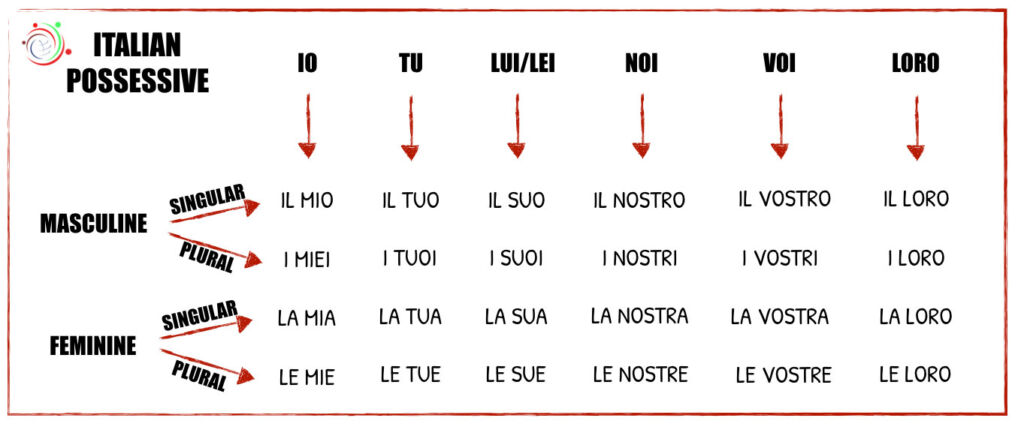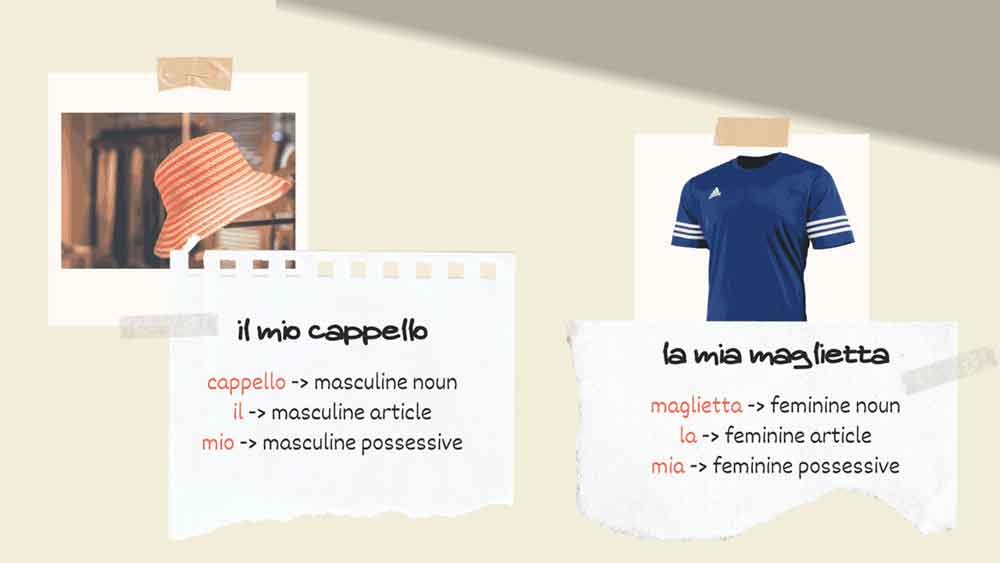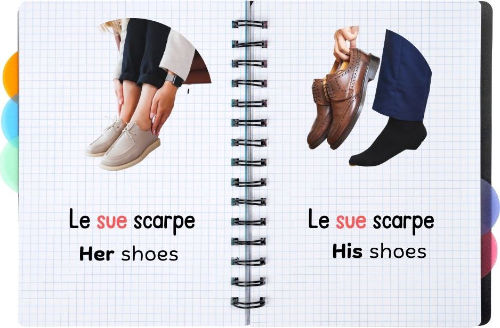Do you make mistakes with possessive adjectives and pronouns? Are you uncertain whether you need an article when using possessives with some words?
Unlike in English, Italian possessive adjectives agree with the noun they describe regarding gender and number. The following article will explain the rules and provide activities to help you learn the Italian possessive adjectives, along with frequently asked questions.
Do you know how to use possessive adjectives and pronouns in Italian? Test what you know with interactive exercises and read the explanation to help you.
Look at these examples to see how articles are used.
- Questa è la vostra insegnante
- Alessio va dal suo amico.
- Venite a casa nostra?
- La casa di Mario ha tre piani, la mia due.
Read the text and pay attention to the possessives:
Ciao Flavia,
Come stai? Io sto molto bene. Adesso vivo a Barcellona.
La città è bellissima, anche il tempo è spesso bello e gli spagnoli sono molto amichevoli.
La mia casa è vicino al mare, ma non vicino al mio ufficio, quindi devo camminare molto. La mia collega si chiama Lorena ed è molto simpatica. La sua casa si trova in centro, vicina al nostro ufficio.
Qualche volta andiamo a cena nel mio ristorante preferito.
Domenica miei vicini di casa mi ha invitato a pranzo: sono molto gentili e con i loro bambini mi sono divertita molto.
Questa famiglia ha anche un cane e un gatto. Il loro cane si chiama Dick e il gatto si chiama Romeo.
Come va la tua vita adesso? Scrivi presto!
Ciao
Marta
mia – mio -miei – loro – tua – are all POSSESSIVE
Possessives are used before a noun to show who it belongs to.
- la mia casa (my house)
- il mio ufficio (my office)
- la mia collega (my colleague)
- la sua casa (his/her house)
- il nostro ufficio (our office)
- il mio ristorante (my restaurant)
- i miei vicini (my neighbours)
- i loro bambini (their children)
- il loro cane (their dog)
- la tua vita (your life)
Possessive pronouns and adjectives in Italian are identical in form (whereas English has the variation ‘my/mine, your/yours’, etc.).
The pronouns are used on their own to refer to something that has already been mentioned or that is present.
The adjectives are always attached to a noun.
How to Form the Possessive in Italian
Like personal pronouns, they have six grammatical ‘persons’
| Masculine Singular | Masculine Plural | Feminine Singular | Feminine Plural | |
|---|---|---|---|---|
| IO | il mio | i miei | la mia | le mie |
| TU | il tuo | i tuoi | la tua | le tue |
| LUI/LEI | il suo | i suoi | la sua | le sue |
| NOI | il nostro | i nostri | la nostra | le nostre |
| VOI | il vostro | i vostri | la vostra | le vostre |
| LORO | il loro | i loro | la loro | le loro |

Each of the six has four possible ends in Italian, which should correspond to the noun they specify:
For example, il mio amico, i miei amici, la mia borsa, le mie borse
Unlike English, Italian forms do not distinguish between “his” and “her”; pay special attention to how suo and sua are used.
il suo cappello
la sua maglietta

Notice how loro is invariable.
It’s also worth noting that the masculine plural forms of mio, tuo, and suo are irregular.
- mio → miei
- tuoi → tuoi
- suo → suoi
How to use the Italian Possessive adjective and pronouns
The possessive adjective and pronouns must agree with the noun.
For example, if the thing possessed is masculine singular, your possessive adjective must be masculine singular as well.
In Italian, possessive forms do not distinguish between “his” and “her,” so it’s important to pay special attention to how “suo” (his) and “sua” (her) are used in sentences to accurately convey possession.
Examples:
Le sue scarpe (feminine) sono nuove. (His shoes are new)
I suoi pantaloni (masculine) sono carini (His pants are nice.)
le sue scarpe (her shoes)
Le sue scarpe (his shoes)

Position of the Italian Possessive adjective
In most cases, the possessive adjective comes before the noun. When it comes after a word, it has a very emphatic or emotive meaning:
Mamma mia! Dio mio!
Qui siamo in casa nostra! (Here we are in our own place! )
Questo dev’essere opera tua! (This must be your work! – ironical)
Distinctions between Possessive Pronouns and Adjectives
Possessive pronouns and adjectives are identical in form (whereas in English they change ‘my/mine, your/yours’, etc.).
Watch the virtual board below to learn more about adjective and pronoun differences.
The possessive adjectives are always preceded by the definite article.
The pronouns are used on their own to refer to something that has already been mentioned or that is present.
Use of article with Italian Possessive adjectives and pronouns
Unlike English, the definite article is part of the possessive. It is not optional.
(In English possessives are never accompanied by articles)
In Italian, the possessives are always preceded by an article, except in a few cases.
Both article and possessive must agree in gender and number with the noun to which they are attached.
Omission of the article with possessive
Sometimes the definite article is not used with possessive adjectives
You don’t need it before some nouns of family members in the singular form.
Possessive with family nouns
There is a special rule for possessive adjectives with family nouns.
We use the possessive without the article for singular family nouns.
- Vado al teatro con mio zio (
don’t say – il mio zio)
- Mia sorella Cinzia ha 30 anni (
don’t say – la mia sorella)
We use the possessive with the article for plural family nouns.
- Vado al teatro con i miei zii (
don’t say – miei zii)
- Le mia sorelle Cinzia e Paola hanno 30 anni (
don’t say – mie sorelle)
| Singular masculine | Singular feminine | Plural masculine | Plural feminine | |
|---|---|---|---|---|
| grandfather grandmother | mio nonno | mia nonna | i nostri nonni | le nostre nonne |
| father mother | mio padre | mia madre | i nostri padri | le nostre madri |
| brother sister | mio fratello | mia sorella | i nostri fratelli | le nostre sorelle |
| uncle aunt | mio zio | mia zia | i nostri zii | le nostre zie |
| cousin | mio cugino | mia cugina | i nostri cugini | le nostre cugine |
| nephew | mio nipote | mia nipote | i nostri nipoti | le nostre nipoti |
| husband wife | mio marito | mia moglie | i nostri mariti | le nostre mogli |
| son doughter | mio figlio | mia figlia | i nostri figli | le nostre figlie |
Additional advanced information about possessive with family nouns
The definite article is used with nouns that are modifications of the basic forms: babbo/papà (dad), mamma (mom), sorellina (little sister), nonnino (small, dear grandfather), and so on.
A definite article is used when the family name is modified by another adjective or includes a suffix.
il mio caro zio (my dear uncle)
il mio fratellino (my little brother)
A definite article is not used with the possessive adjective when the adjective comes after the noun in an expression or in exclamations.
A mio parere… Dio mio! (In my opinion . . . My God!)
Cara mia! (My dear!)
Mamma mia! Oh my! (idiomatic)
Omission of the possessive
In English, the possessive is commonly used to indicate personal belongings or relationships, and parts of the body.
In Italian, when the relationship or ownership is obvious, as in the examples shown, the possessive is not used.
This is particularly true when referring to parts of the body or items of clothing, where a reflexive pronoun is often used instead:
Porterò la macchina. (I’ll bring my car.)
Aveva una giacca sulle spalle. (She had a jacket over her shoulders)
FAQs about Italian Possessive Adjectives
Q1: Do possessive adjectives in Italian always need an article? A1: Generally, yes. Unlike English, Italian possessive adjectives are usually preceded by a definite article. However, there are exceptions, such as when referring to singular family members (e.g., mio padre, tua madre).
Q2: How do I know which form to use? A2: The form of the possessive adjective depends on the gender and number of the noun it describes. Always match the adjective to the noun, not to the possessor.
Q3: What about “loro”? Does it change? A3: “Loro” is an exception and does not change for gender or number. It remains the same in all cases.
Q4: Can possessive adjectives come after the noun? A4: No, in Italian, possessive adjectives always precede the noun.
Q5: Is there any difference between “suo” and “sua”? A5: Yes, “suo” is used for masculine singular nouns, and “sua” is used for feminine singular nouns. Similarly, “suoi” and “sue” are for masculine and feminine plural nouns, respectively.
Conclusion
Mastering possessive adjectives and pronouns is a vital part of becoming fluent in Italian. Practice regularly with the activities provided, and soon you’ll find using them becomes second nature. Remember, consistency is key!
Feel free to share your practice sentences or any questions you have in the comments below. Buona fortuna!

What’s next?
You might want to keep learning Italian online with these free resources:










Leave a Reply